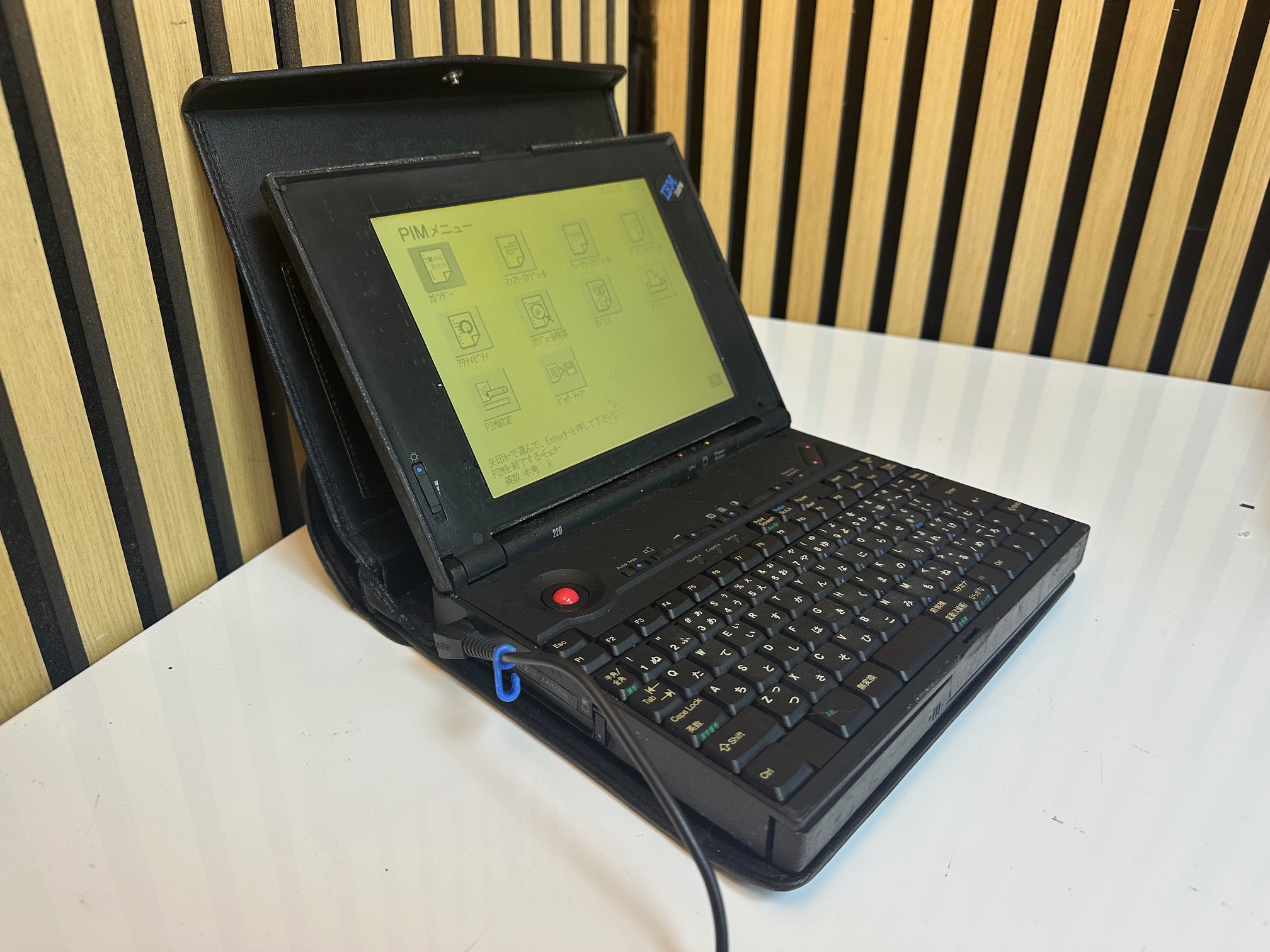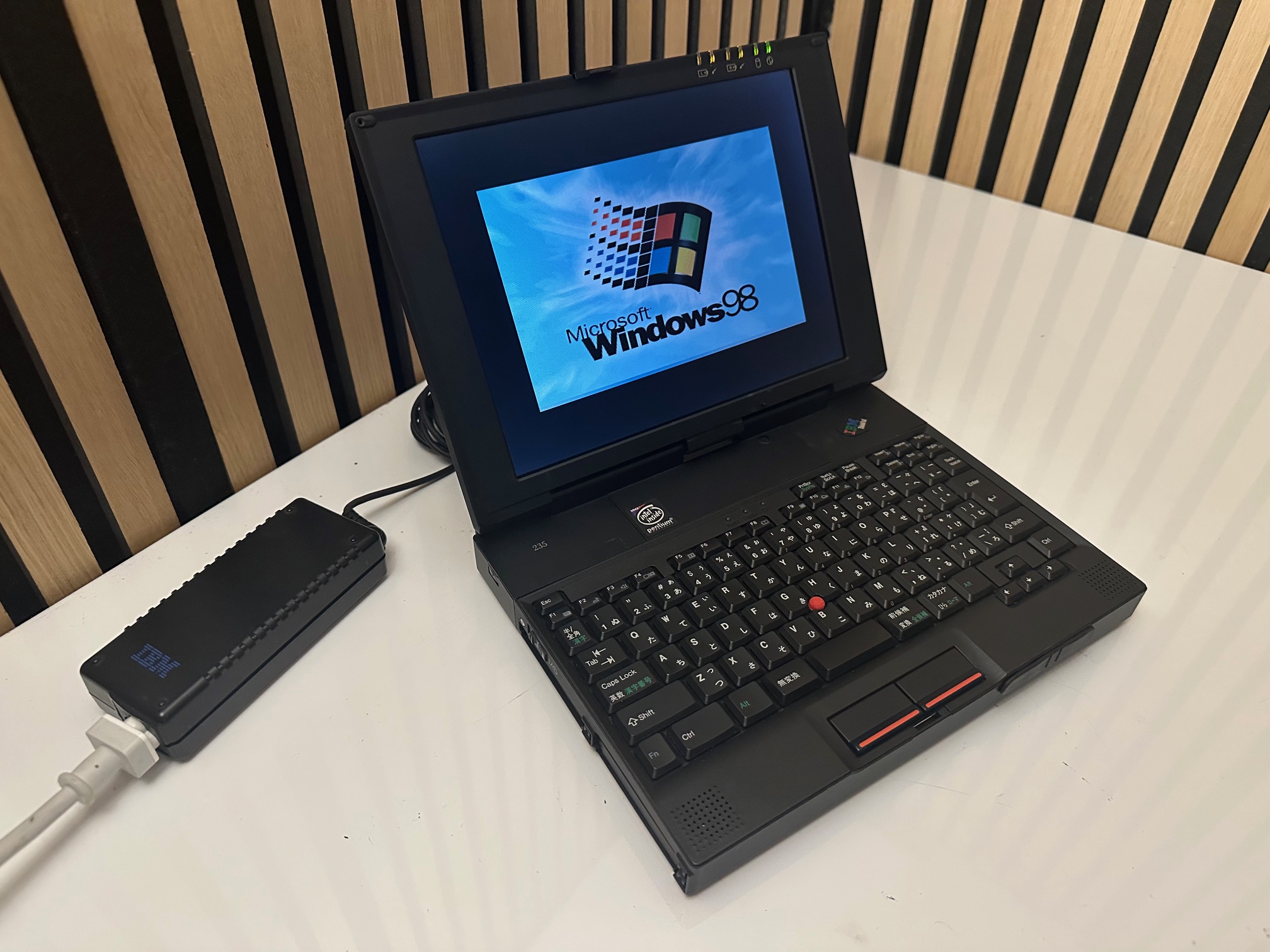These were almost all Type 24xx and 26xx machines which were aimed at the ultraportable, ultracompact market. None of them had built-in removable floppy or optical drives. Here we have the added benefit of the numbers being almost entirely chronological!
The series had two outliers within it, which were certainly related to the 2xx series - the non-Thinkpad (PT not TP!) Palm Top PC110 -which is perhaps why there is no 210 Model and the Risc-based Workpad Z50 - which looks awfully similar to the 240 models but is not intel-based.
The series got off to a rocky start with the unreleased 200, the rarely-spotted, Japan-only PS/55 S33V and the non-trackpoint Japanese 220. None of these were really the full-Thinkpad package, but certainly informed the direction of travel for the series, showcasing good and bad ideas which ultimately enabled more wins than fails.. The rest were increasingly successful and increasingly acceptable as the miniature technology came of age.
What came after briefly evolved into the standlone S30 & Transnote and the more successful, but not-as small X-Series. I think IBM had realised successfully small doesn't have to be smallest-on-the-market!
Here is the timeline:

200 Prototype
RIOS was a joint venture between IBM and Ricoh, which obviously put some effort and money into R&D. This is a stolen picture and indeed the only picture I can find of the 200.

This was perhaps the first of the 2xx Series before the 2xx series was born. It was a very small, portable, non-backlit, 386 computer, which looked a bit like the HP 200LX (another x86 DOS-based ultraportable). If anything, it was perhaps too wee. Also perhaps IBM had seen the performance of these non-backlit greyscale screens and realised the executive on the move would not venture where the Game Boy owner had gone.
It was never released.
PS/55 S33V
I have no idea what this machine is, other than it not being an ultraportable due to it's 10.4" screen. The only reason I mention it here is because it shares the Type 24xx with all the other 2xx models.
220
The 220 was another japanese RIOS design, when the entire subnotebook industry was still trying to make a good, small, usable, efficient screen. Which had not yet been designed. It's release preceeded the success of the Trackpoint II and therefore didn't have one! Instead it has a cute little red trackball. These are often in rough shape now and the screens all tend to succum to at least partical rot which looks like fractals.

230Cs
I'm sure this machine started with the best intentions. It was a lovely, sturdy little machine, albeit with a weak DSTN backlit display. It was tiny and it was powerful.

However, since about 2010 they've all been committing Harakiri on themselves because a little three-cell Varta hibernation battery, nestled inbetween a DC/DC power "84G8486 Power Sub-Card with coils and electrolytic capacitors" board and the motherboard has been gradually leaking out noxious fumes. This is effectively eating all the tracks, ICs, resistors and diodes on the DC boards and killing them all.
Also nearly all 230Cs trackpoints die for no discernable reason and due to their Japan-only release, nearly all the Citizen screens (which are 1 digit apart from the PC110 screen) have turned to Vinegar.
The 230Cs is frequently paired in training and marketing literature with the equally flawed 530Cs.
This picture shows how the 230Cs compares in shape and size to the incumbent 235:

Palm Top PC110
This was a weird little 486 computer, which was a jack of a lot of trades but no master. It was tiny - smaller than a VHS cassette, it was intel, it ran from IBM Microdrives or solid state compact flash cards (as well as having a small amount of non-volatile memory onboard to hold a small operating system of it's own) and it doubled up as a mobile phone (with MIC and speaker doubling as slide-buttons on the front). The keyboard was tiny and quite difficult to use in combat. There was a trackpoint-y style pushing pointing device thing and a weird stylus, type touch panel as well.
As with the 230Cs, these have been self sabotaged over time in a number of ways. The screen regularly goes bad as the polariser glue turns to mush. The main batteries fail, leak and destroy anything around them. And the hidden 'bridge' or hibernation battery hidden deep within is a flawed Varta unit which leaks out corrosive gas, rotting anything around it. As a result, you have to be very careful buying a second-hand PC110, as they're likely to be fraught with invisible damage on the inside, or they've been previously rescued and therefore likely to be in better shape and more valuable.
235
RIOS also developed a machine codenamed Chandra, which was initially taken up by Ricoh, Hitachi and Epson and released as their own laptops. All well-trained eye could see the cues from other RIOS-designs with features such as the camcorder batteries. Eventually IBM also released their own version of the Chandra design, only in Japan and under the 235 badge. The Chandra design has a huge fan following in Japan and despite these not being purebred IBM machines, they're lovely, cute machines with few flaws.

As a weird size comparison, here is a (backleft) 240Z, X21 (backright), Workpad Z50 (bottom left) and S30 (bottom right).

Workpad Z50
Despite it's looks, size and portability, this was presumably not marketed as a 2xx series machine due to it's very different architecture to the rest of the series. Sporting a RISC CPU, solid state memory, WindowsCE and a DSTN screen, it was perpetually in a state of awake or asleep, but hardly ever off. You could run it on it's own Li-Ion battery pack, or AA batteries. It was a very usable machine for keeping notes, editing basic spreadsheets, maintaining contacts and a schedule, but other fully-blown, proper-Windows computers were starting to chase it's tail, with almost infinately more power, software and definitely a nicer screen.

240, 240X and 240Z
These were the ultimate 2xx Series machine - perhaps because they were the only IBM-produced machines in the series with a fully evolved, practical use of TFT, Trackpoint and Bentobox. They were very usable and perhaps the hedged-bet against the Workpad Z50 - a similar size, but with a proper processor and a proper screen.
I was personally just a little bit disappointed about two elements of this machine. The plastic nature of the machine was very plasticky. I mean, the 230Cs and the 235 were very plastic machines, but they felt very solid. The 240 feels a little hollow. The second disappointment was the screen. Nearly all 240 models were SVGA only, except a very brief final burst of excitement with a few final 240Z machines which had a XGA screen. However some of these XGA screens are handicapped by only having half the necessary VRAM to support 16 or 24-bit colour.
A 240Z with Windows 2000, XGA and 4Mb VRAM has a special kind of power-user about it.
There are some 240 machines with funky lids - some are black and some are glossy dark grey with a cool sheen to them. I love black, but the odd flare is a special, modest treat.
As an aside, the Thinkpad 240 was also released in Asia as an iSeries 1124. I have no idea why apart from the iSeries branding had a certain amount of intertia by then.
In the image below, the top-left is a 240Z and the bottom-left is a Workpad Z50 and you can see that their size and exterior design and layout is almost the same:

Transnote
The Transnote is not in any way a 2xx series computer. It's not even a Thinkpad. I'm not sure what you'd call it but it's in the form of a large leatherette-bound notepad with a Thinkpad 240 in-a-nicer-case on one side and a Cross Crosspad on the other. You could use the computer to do computer shit and when you wanted to show off in board meetings, you could write notes on the paper side, which would live on for eternity in paper and ink, whilst being digitally transcribed into your computer. Lovely stuff.